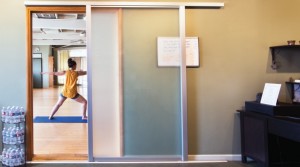 Known as particularly versatile architectural elements, pocket doors are there when you need privacy and gone when you don’t. Selecting the door is a straightforward process. Whichever style suits the architecture of your house is something you can decide on when you are ready to get that out of the way. Choosing the hardware, pulls and the tracks is a much more in depth and lengthy process. This is what you’ll want to consider as you get started.
Known as particularly versatile architectural elements, pocket doors are there when you need privacy and gone when you don’t. Selecting the door is a straightforward process. Whichever style suits the architecture of your house is something you can decide on when you are ready to get that out of the way. Choosing the hardware, pulls and the tracks is a much more in depth and lengthy process. This is what you’ll want to consider as you get started.
Tracks
Ceiling track
Put first things first. Selecting the proper track system for the doors to slide on is how it all starts. Most situations call for pocket doors to be “top-hung.” The track is set in the recess of the doors opening, and is affixed to the rolling trolley hardware known as “running gear.,” Trolleys resemble a small set of roller skates that smoothly ride the rails. The track and trolleys must then be sized to carry the weight of the door.
A track system called the Hawa Junior is a favorite of architects. Tracks made from extruded aluminum, are very stable, uniform and lightweight. Typically trolleys roll on a dual nylon wheels with ball bearings system. This combination makes for minimal rolling resistance and quiet opening and closing. Choosing a full height sliding door can maximize the opening and minimize the perception that it’s a door opening when the pocket door is completely open. Recessing the track demands a high-quality track, but will offer a clean, modern aesthetic. This is a permanent detail, which offers superb durability so expect the price to reflect that.
Ceiling and floor track (multi-pass sliders).
With multi-pass sliding doors, you need some means of keeping the bottom of the doors in line and sliding as normal. A floor track or guide will hold them in place. The trip hazard and accumulation of debris between sliders makes this door best suited for lower trafficked areas.
At least one floor guide will come standard with a pocket door to keep the bottom in the proper orientation. Sliding door track hardware comes in many different styles and types, not just solid wood ones. Depending on the door substrate the trolley interface will be slightly different, but the track will remain the same.
Bi-parting pocket track.
The is the type you’ll want to find a method of centering the doors to prevent any collisions between panels. Some tracks come with inner adjustable bumpers within the track. Bumpers serve as small finger like objects that grab the trolley, stopping it at a fixed point, and are set at the center to keep the doors in the precise position you’d like.
Mounting.
Steer clear of those inexpensive pocket doors that mount to a cutout in the edge of a door with a tiny indent and a small thumb-turn nib for locking. Hardware like that will make you hate pocket doors. Yes, they’re inexpensive, true, but they fail to meet that standard of excellence set like the one seen here at sliding doors culver city.
Choose a mortised set for its looks, ease of use, and functionality. This is more pleasant because it moves the recessed parts of the pull away from the door edge. A mortised set allows you easier access for your hands, and thanks to its larger size it’s easy to grip.
Pulls
The pull is by far the most visual aspect of the pocket door hardware selection process and we will end with a brief survey of the different kinds. There is no end to the choices available when it comes to size and shape. The pull of your door should be easy for you to grip and comfortable to use in everyday situations. The door must fit within a limited pocket thickness, most pulls on pocket doors are known as “flush pulls, which is fancy for a pull that doesn’t protrude from the face of the door stile.
Choosing your pull might be made easier by opting for crisp corners and, for most projects, concealed fastening. The pulls base material should be selected to match the projects theme and intended use of the door. A good to default option is stainless steel, but cast brass, bronze and plated finishes fit in nicely in certain settings.
- Circular pulls. Pay close attention to the diameter of circular styled pulls. Too small on a large door means usability at the expense of comfort. Start toward the 2-inch range for anything more complicated than a cabinet door. Selecting the right round pull adds a charming appeal when set with door slabs.
- Rectangular pulls.This pull is best for a solid wood door and thanks to its minimal profile can serve as a flush and an edge pull. A nice flush pull can match the vertical proportion of a door opening and fit comfortably in the width of the door stile at the same time. A pull that’s too wide for the stile will stand out as an awkward eye sore.
- Bar pull or surface-mounted pulls. Perfection for making a pocket door handicapped accessible.
- Custom pull. Sometimes the hardware you like is not in stock or too hard to find. In that case consider a custom solution like a carved out a flush pull from the face of the door with an easy to grab and slide configured door edge.
- Design your own pull. Perhaps this will be your favorite of all of the examples because it employs your creativity, innovation and simplicity to solve the problem of door hardware and privacy.
- No Pull.As simple and basic as it comes these doors take a little more dexterity to move, but the savings can add up the locking functions aren’t that important. A recessed edge pull can be added to help with the operation of a hardware-free slider which is required in a pocket door.
Related: http://www.knrslidingdoors.com/custom-sliding-closet-doors/

